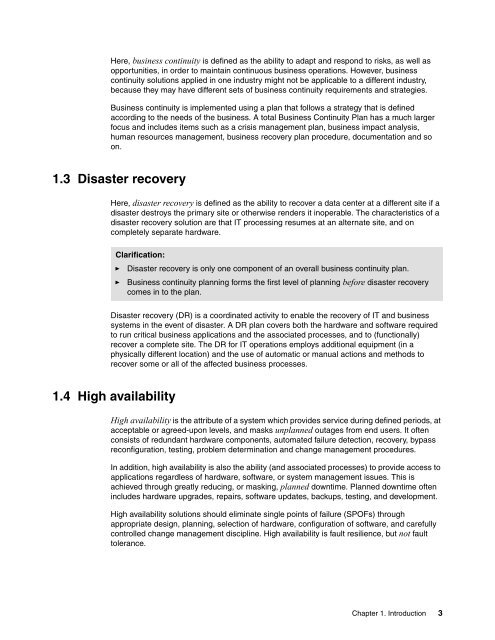IBM AIX Continuous Availability Features - IBM Redbooks
IBM AIX Continuous Availability Features - IBM Redbooks
IBM AIX Continuous Availability Features - IBM Redbooks
You also want an ePaper? Increase the reach of your titles
YUMPU automatically turns print PDFs into web optimized ePapers that Google loves.
Here, business continuity is defined as the ability to adapt and respond to risks, as well as<br />
opportunities, in order to maintain continuous business operations. However, business<br />
continuity solutions applied in one industry might not be applicable to a different industry,<br />
because they may have different sets of business continuity requirements and strategies.<br />
Business continuity is implemented using a plan that follows a strategy that is defined<br />
according to the needs of the business. A total Business Continuity Plan has a much larger<br />
focus and includes items such as a crisis management plan, business impact analysis,<br />
human resources management, business recovery plan procedure, documentation and so<br />
on.<br />
1.3 Disaster recovery<br />
Here, disaster recovery is defined as the ability to recover a data center at a different site if a<br />
disaster destroys the primary site or otherwise renders it inoperable. The characteristics of a<br />
disaster recovery solution are that IT processing resumes at an alternate site, and on<br />
completely separate hardware.<br />
Clarification:<br />
► Disaster recovery is only one component of an overall business continuity plan.<br />
Disaster recovery (DR) is a coordinated activity to enable the recovery of IT and business<br />
systems in the event of disaster. A DR plan covers both the hardware and software required<br />
to run critical business applications and the associated processes, and to (functionally)<br />
recover a complete site. The DR for IT operations employs additional equipment (in a<br />
physically different location) and the use of automatic or manual actions and methods to<br />
recover some or all of the affected business processes.<br />
1.4 High availability<br />
► Business continuity planning forms the first level of planning before disaster recovery<br />
comes in to the plan.<br />
High availability is the attribute of a system which provides service during defined periods, at<br />
acceptable or agreed-upon levels, and masks unplanned outages from end users. It often<br />
consists of redundant hardware components, automated failure detection, recovery, bypass<br />
reconfiguration, testing, problem determination and change management procedures.<br />
In addition, high availability is also the ability (and associated processes) to provide access to<br />
applications regardless of hardware, software, or system management issues. This is<br />
achieved through greatly reducing, or masking, planned downtime. Planned downtime often<br />
includes hardware upgrades, repairs, software updates, backups, testing, and development.<br />
High availability solutions should eliminate single points of failure (SPOFs) through<br />
appropriate design, planning, selection of hardware, configuration of software, and carefully<br />
controlled change management discipline. High availability is fault resilience, but not fault<br />
tolerance.<br />
Chapter 1. Introduction 3

















